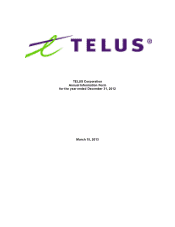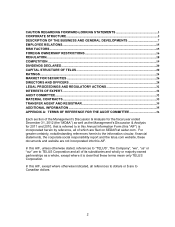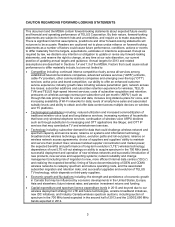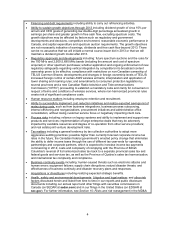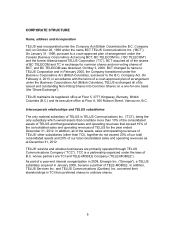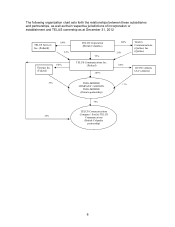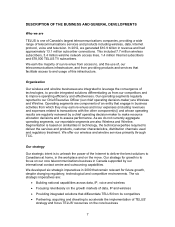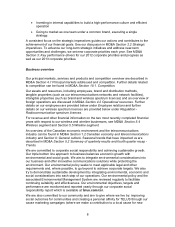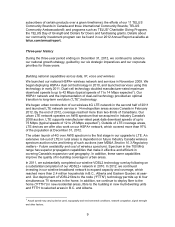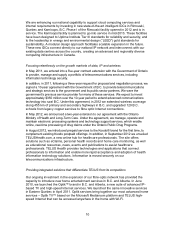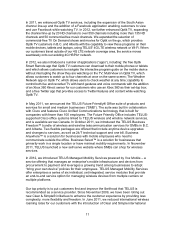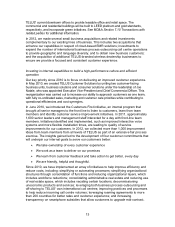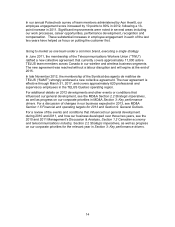Telus 2012 Annual Report Download - page 4
Download and view the complete annual report
Please find page 4 of the 2012 Telus annual report below. You can navigate through the pages in the report by either clicking on the pages listed below, or by using the keyword search tool below to find specific information within the annual report.
4
• Financing and debt requirements including ability to carry out refinancing activities.
• Ability to sustain growth objectives through 2013 including dividend growth of circa 10% per
annum and CEO goals of generating low double-digit percentage annualized growth in
earnings per share and greater growth in free cash flow, excluding spectrum costs. The
growth objectives may be affected by factors such as regulatory and government
developments and decisions, competitive environment, reasonable economic performance in
Canada, and capital expenditure and spectrum auction requirements. The growth objectives
are not necessarily indicative of earnings, dividends and free cash flow beyond 2013. There
can be no assurance that we will initiate a normal course issuer bid in 2013 or that we will
maintain a dividend growth model after 2013.
• Regulatory approvals and developments including: future spectrum auctions and the rules for
the 700 MHz and 2,500-2,690 MHz bands (including the amount and cost of spectrum
acquired) or other spectrum purchases; whether application and ongoing enforcement of new
regulatory safeguards regarding vertical integration by competitors into broadcast content
ownership prove to be effective; compliance with restrictions on non-Canadian ownership of
TELUS Common Shares; developments and changes in foreign ownership levels of TELUS;
increased foreign control of certain AWS wireless entrants; interpretation and application of
tower sharing and roaming rules; and amendments to consumer protection legislation by
several provinces and a new Canadian Radio-television and Telecommunications
Commission (“CRTC”) proceeding to establish a mandatory code and clarity for consumers in
respect of terms and conditions of wireless services, where non-harmonized provincial rules
create risk of significant compliance costs.
• Human resource matters including employee retention and recruitment.
• Ability to successfully implement cost reduction initiatives and realize expected savings net of
restructuring costs, such as from business integrations, business process outsourcing,
internal offshoring and reorganizations, procurement initiatives and administrative office
consolidation, without losing customer service focus or negatively impacting client care.
• Process risks including: reliance on legacy systems and ability to implement and support new
products and services; implementation of large enterprise deals that may be adversely
impacted by available resources and degree of co-operation from other service providers;
and real estate joint venture development risks.
• Tax matters including a general tendency by tax collection authorities to adopt more
aggressive auditing practices; possible higher than currently forecast corporate income tax
rates in the future; the Canadian federal government’s enacted policy change that eliminates
the ability to defer income taxes through the use of different tax year-ends for operating
partnerships and corporate partners, which is expected to increase income tax payments
commencing in 2014; costs and complexity of complying with the Province of British
Columbia’s reversal of its harmonized sales tax back to a separate provincial sales tax and
federal goods and services tax, as well as the Province of Quebec’s sales tax harmonization;
and international tax complexity and compliance.
• Business continuity events including: human-caused threats such as electronic attacks and
human errors; equipment failures; supply chain disruptions; natural disaster threats; and
effectiveness of business continuity and disaster recovery plans and responses.
• Acquisitions or divestitures including realizing expected strategic benefits.
• Health, safety and environmental developments; Litigation and legal matters; and other risk
factors discussed herein and listed from time to time in our reports and public disclosure
documents including our annual report and other filings with securities commissions in
Canada (on SEDAR at sedar.com) and in our filings in the United States (on EDGAR at
sec.gov). For further information, see Section 10: Risks and risk management in the MD&A.

